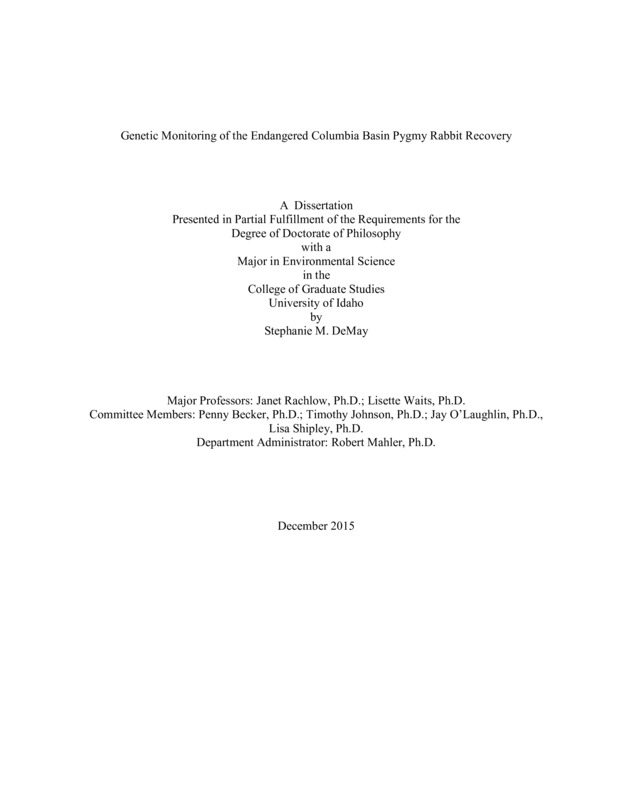Genetic Monitoring of the Endangered Columbia Basin Pygmy Rabbit Recovery
DeMay, Stephanie. (2015). Genetic Monitoring of the Endangered Columbia Basin Pygmy Rabbit Recovery. Theses and Dissertations Collection, University of Idaho Library Digital Collections. https://www.lib.uidaho.edu/digital/etd/items/demay_idaho_0089e_10754.html
- Title:
- Genetic Monitoring of the Endangered Columbia Basin Pygmy Rabbit Recovery
- Author:
- DeMay, Stephanie
- Date:
- 2015
- Keywords:
- endangered species genetic monitoring pygmy rabbit reintroduction
- Program:
- Environmental Science
- Subject Category:
- Wildlife conservation; Genetics
- Abstract:
-
Monitoring demographic and genetic parameters of reintroduced populations of endangered species is crucial for evaluating and informing conservation strategies to maximize the chances of a successful recovery. I developed a suite of 19 microsatellite loci to enable genetic monitoring of the recovery of the Columbia Basin pygmy rabbit in central Washington, USA. I performed a pilot study evaluating degradation rates of fecal DNA and compared the advantages, disadvantages, and costs of noninvasive genetic monitoring using fecal DNA with radio telemetry, another common monitoring method. Finally, I used these molecular tools to evaluate reproduction and population genetic trends inside large field breeding enclosures, and post-release dispersal, survival, and reproduction of pygmy rabbits reintroduced to the wild. DNA degradation was influenced by sample age, DNA type, locus length, sex of the rabbit, and weather conditions. Systematic surveys to monitor the reintroduced population took place during winter to maximize success rates for genetic samples.
Tissue samples were collected from all pygmy rabbits released to the wild during the summers of 2012-2014 to generate a database of reference genotypes. From this data I characterized and evaluated breeding habits of pygmy rabbits in the enclosures. They displayed a promiscuous mating system, multiple paternity within litters was common, juvenile breeding occurred on rare occasions, and reproductive output was influenced by genetic diversity, population density, and paternal ancestry.
Each winter following releases we surveyed on and around the release area to locate active burrows and collect fecal pellets. Fecal genotypes were used to evaluate post-release dispersal, survival, and reproduction. Compared with telemetry of juvenile pygmy rabbits, fecal DNA sampling provided information for a longer time period, although at a coarser temporal scale. Over the course of this study, 1206 pygmy rabbits were released to the wild, and we detected 44-91 surviving each year. Survival differed across years and was positively influenced by release date, release weight, and heterozygosity. Reproduction was low, with only 14 wild-born individuals detected. Three years in to the renewed reintroduction effort, this project is in its infancy. Within an adaptive management framework, this research provides information to guide future recovery actions.
- Description:
- doctoral, Ph.D., Environmental Science -- University of Idaho - College of Graduate Studies, 2015
- Major Professor:
- Rachlow, Janet L; Waits, Lisette P
- Committee:
- Becker, Penny A; Johnson, Timothy R; O'Laughlin, Jay; Shipley, Lisa
- Defense Date:
- 2015
- Identifier:
- DeMay_idaho_0089E_10754
- Type:
- Text
- Format Original:
- Format:
- application/pdf
- Rights:
- In Copyright - Educational Use Permitted. For more information, please contact University of Idaho Library Special Collections and Archives Department at libspec@uidaho.edu.
- Standardized Rights:
- http://rightsstatements.org/vocab/InC-EDU/1.0/

